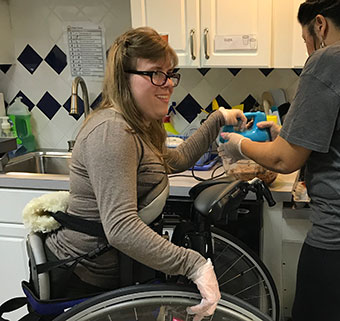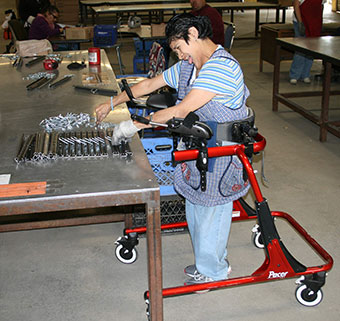Great Outcomes for Adults Who Need Gait Assistance
The Rifton TRAM Plus Adequate Funding Equals Happy Clients
| September 2015 For children with complex disabilities the transition from school to adult services can be brutal: therapy and equipment that is considered standard in the school suddenly disappears, funding evaporates, and families struggle to bridge the gap. But this is slowly changing. Many healthcare facilities now try to provide a seamless transition into this new stage of life with specialized and comprehensive medical services. One of these, located in the Midwest, we’ve been following with interest, and we noticed recently a strong interest in the Rifton TRAM there and decided to find out more. I spoke over the phone with one of their physical therapists—I’ll call her Lisa—who works in their rehab department.
For children with complex disabilities the transition from school to adult services can be brutal: therapy and equipment that is considered standard in the school suddenly disappears, funding evaporates, and families struggle to bridge the gap. But this is slowly changing. Many healthcare facilities now try to provide a seamless transition into this new stage of life with specialized and comprehensive medical services. One of these, located in the Midwest, we’ve been following with interest, and we noticed recently a strong interest in the Rifton TRAM there and decided to find out more. I spoke over the phone with one of their physical therapists—I’ll call her Lisa—who works in their rehab department.
Rifton: What type of diagnoses do the majority of your clients have?
Lisa: Most of the clients who use the TRAM have cerebral palsy but some have had TBI for many years previously, or stroke.
Rifton: How does the TRAM figure in their rehab?
Lisa: We work with many patients who are having a difficult time with transfers and who are unable to stand or to walk. Some of these patients had been able to do a stand-pivot transfer or walk with a walker or gait trainer in the past, but because their health progressively declined they can no longer safely walk or transfer.
A few of the patients we see live with aging parents or in group homes. So we’re asked to evaluate the patient for transfer and standing equipment at home where there are space limitations. So if during the evaluation or subsequent treatment sessions we determine that the patient cannot learn to do stand pivot transfers safely or walk with less restrictive equipment, we often opt to trial the TRAM. One of our favorite features of the TRAM is that it truly is a 3-in-1 device, so that it can be used for transfers, standing and walking, which works great for home use where clients want as few pieces of equipment as possible.
In therapy, we also trial many other walking devices as appropriate, including reverse walkers and standard gait trainers. If it is determined that the patient does not have the stability to use any of these walkers safely, or if it is too risky for a single caregiver to get them in and out of the gait trainer, then the TRAM can be ideal and we’ve had great success with it.
We then work on teaching caregivers how to assist the client with all three functions of the TRAM. Finally, if we’re all agreed that the TRAM is right for the client we produced a detailed DVD showing correct use and positioning so that the client and caregiver have a good reminder once they leave. We also often provide a written list of TRAM uses with step by step instructions for transfers, standing and walking.
Rifton: How do you get funding approval for the TRAMs that you recommend for your clients?
Lisa: In our state, insurers require a weeklong in-home trial before approving a device. Three of our local DME vendors have TRAMs with all the accessories so they bring the TRAM out to the home for the trial. In the meantime, therapy provides trial logs and sets up goals in conjunction with the client. This always includes instructions to use the TRAM every day for at least 30 minutes. The trial log then goes back to the DME provider who sends it to both the insurer and therapist. And of course we include the results of these trials in our letters of medical necessity.
This has proven effective. Occasionally we get some push back and need to follow up with an appeal, but a strong letter of medical necessity generally carries the day.
Rifton: Initially you were skeptical of the TRAM. What changed?
Lisa: Because in the beginning insurance would not cover the TRAM and it was too expensive for our patients to pay for privately we tended to avoid it. I had also used the Rifton Pacer for many years successfully so would encourage people to keep on using the Pacer even if this required a two-person assist. But now that TRAM is a covered item I trial it often.
Additionally, I had trouble at first using the TRAM with obese people – a large abdominal girth – because the body support would slide up creating an uncomfortable and ungainly lift. But I’ve discovered all kinds of techniques to lift larger people or people with low tone, and I feel so much more confident with the TRAM. That has made all the difference.
And finally, so many of our clients and caregivers are so happy with the TRAM and love having one piece of equipment which can safely carry out so many functions (saving them money and space). And the TRAM is great for safety. Many people can walk well in a gait trainer, but are very difficult and unsafe to transfer into the gait trainer. With the TRAM, they can safely and easily transfer and then go straight into gait training with the assistance of just one caregiver.
Are you a therapist using the TRAM for patients with complex disabilities? We would love to hear your story and welcome you to share in the comments below.


